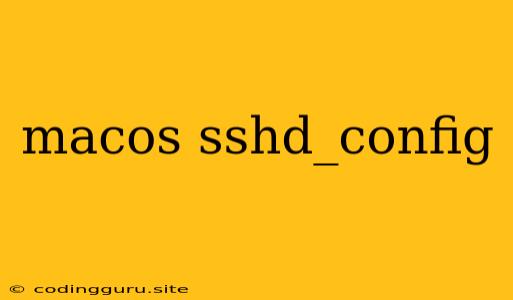Mastering SSHD Configuration on macOS: A Comprehensive Guide
SSH, or Secure Shell, is a fundamental tool for remote access and administration. On macOS, the SSH daemon, sshd, plays a crucial role in enabling secure connections. Configuring sshd effectively is essential for maintaining a robust and secure environment.
Understanding the SSHD_CONFIG File
The core of sshd configuration lies within the sshd_config file, typically located at /etc/ssh/sshd_config. This file contains directives that control various aspects of the SSH daemon, including:
- Port: The port on which SSH listens for connections.
- Authentication: Methods for user authentication, such as password-based or key-based authentication.
- Security: Options related to security, including access control and encryption.
- Logging: Configuration for logging SSH events.
How to Edit SSHD_CONFIG
Editing sshd_config requires administrative privileges:
- Open Terminal: Launch the Terminal application on your macOS system.
- Use sudo: Utilize the
sudocommand to gain root access:sudo nano /etc/ssh/sshd_config - Edit the file: Modify the desired directives.
- Save and quit: Save the file (typically by pressing Ctrl+X, Y, Enter) and quit the editor.
- Restart SSHD: Restart the SSH daemon to apply the changes:
sudo systemctl restart sshd
Essential SSHD_CONFIG Directives
Port:
- Default: 22
- Changing the Port:
This changes the SSH port to 2222.Port 2222
Authentication:
-
PasswordAuthentication:
PasswordAuthentication yesEnables password-based authentication (default).
PasswordAuthentication noDisables password-based authentication for enhanced security.
-
PubkeyAuthentication:
PubkeyAuthentication yesEnables public key authentication, a more secure method.
Security:
-
PermitRootLogin:
PermitRootLogin noDisables direct root login for better security.
-
AllowUsers:
AllowUsers user1 user2Allows specific users to connect.
-
DenyUsers:
DenyUsers user3Denies specific users from connecting.
-
AllowGroups:
AllowGroups group1 group2Allows connections from users belonging to specific groups.
-
DenyGroups:
DenyGroups group3Denies connections from users belonging to specific groups.
Logging:
-
SyslogFacility:
SyslogFacility AUTHSpecifies the syslog facility for SSH logging.
-
LogLevel:
LogLevel INFOSets the logging level.
Common SSHD_CONFIG Issues and Troubleshooting
Error: "Connection refused": This often indicates a problem with the SSH daemon:
- Check if SSH is running: Use
ps aux | grep sshdto see if the daemon is active. - Restart SSHD: If it's not running, restart it with
sudo systemctl restart sshd. - Firewall: Ensure that port 22 (or the configured port) is open in your firewall.
Error: "Permission denied": This suggests an authentication issue:
- Check SSH config: Review the authentication settings in sshd_config (e.g.,
PasswordAuthentication,PubkeyAuthentication). - Check user privileges: Verify that the user attempting to connect has the necessary permissions.
Error: "No matching cipher": This indicates a cipher mismatch between the client and server:
- Check client and server configurations: Make sure both the client and server support compatible ciphers.
- Update SSH versions: Consider updating the SSH client and server to the latest versions.
Error: "Could not resolve hostname": This signifies a DNS resolution problem:
- Check DNS settings: Verify that the DNS server is properly configured.
- Check hostname: Ensure that the hostname is correct and resolvable.
Best Practices for SSHD_CONFIG
- Minimize Risk: Limit password-based authentication and use public key authentication whenever possible.
- Enable Logging: Keep detailed logs for security auditing.
- Regularly Review: Periodically review sshd_config to ensure it aligns with security best practices.
- Test Changes: Test any changes made to sshd_config before applying them permanently.
Conclusion
By carefully configuring sshd_config, you can strengthen the security of your macOS system and establish a secure environment for remote access. Regularly reviewing and adjusting the configuration is crucial for mitigating potential security vulnerabilities.
